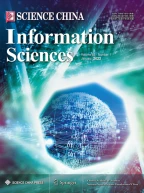209Accesses
10Citations
Abstract
Co-occurrence networks of Chinese characters are constructed from collections of essays in different periods of China: the ancient Chinese language, the Chinese language in Wei, Jin, and Southern-Northern Dynasties, the recent Chinese language, and the modern Chinese language, and their statistical parameters are studied. It has been found that 99.6% networks have the scale-free feature and 95.0% networks have the smallworld effect. This study reveals some commonalities and differences among articles in different periods of China from a complex network perspective. There has been a controversial question as to whether the literatures in Wei, Jin, and Southern-Northern Dynasties should belong to the ancient Chinese language or the recent Chinese language in the linguistic study. Our work shows that the statistical parameters of networks in Wei, Jin, and Southern-Northern Dynasties are clearly different from those of networks in the other periods of China, and it seems more reasonable that the literatures in Wei, Jin, and Southern-Northern Dynasties belong to the recent Chinese language.
This is a preview of subscription content,log in via an institution to check access.
Access this article
Subscribe and save
- Get 10 units per month
- Download Article/Chapter or eBook
- 1 Unit = 1 Article or 1 Chapter
- Cancel anytime
Buy Now
Price includes VAT (Japan)
Instant access to the full article PDF.
Similar content being viewed by others
References
Steels L. Language as a complex adaptive system. In: Lecture notes in Computer science. Berlin: Springer-Verlag, 2000
Grimes B F. Ethnologue: Languages of the World. 14th ed. Dallas: TX: Summer Institute of Linguistics, 2000
Wei L, Li Y, Kang S, et al. Organizational structure and scale-free properties of Chinese words networks. Chin Sci Bull, 2005, 50: 1575–1579
Liu Z, Sun M. Chinese word co-occurrence network: its small world effect and scale-free property. J Chin Inf Process, 2007, 6: 52–58
Zhou S, Hu G, Zhang Z, et al. An empirical study of Chinese language networks. Phys A, 2008, 387: 3039–3047
Liu H. The complexity of Chinese synatactic dependency networks. Phys A, 2008, 387: 3048–3058
Tang L, Zhang Y, Fu X. Structures of semantic networks: how do we learn semantic knowledge. J Southeast Univ, 2006, 22: 413–417
Shi Y, Liang W, Liu J, et al. Structural equivalence between co-occurrences of characters and words in Chinese language. In: Int. Symposium on Nonlinear Theory and its Appl. Budapest, 2008. 94–97
Liang W, Shi Y, Tse C K, et al. Comparison of co-occurrence networks of the Chinese and English languages. Phys A, 2009, 388: 4901–4909
Zhang F, Zhao J. History of Ancient Chinese Literature (I). Tianjin: Nankai University Press, 2003
Ma J, Huang J. Ancient Chinese Literature. Changsha: Hunan Art Publishing House, 2006
Gao Y. Ancient Chinese system and ancient Chinese cultural type. The J Xinjiang Univ (Social Sci), 2003, 31: 84–90
Zhou J. Ancient Chinese Literature. Nanjing: Nanjing University Press, 2003
Zhang Y. History of Ancient Chinese Literature (II). Tianjin: Nankai University Press, 2003
School of Chinese Language and Culture, Beijing Normal University. Ancient Chinese Literature. Beijing: Beijing Normal University Press, 2008
Ning J, Li R. History of Ancient Chinese Literature (III). Tianjin: Nankai University Press, 2003
Zhang Y. A summary of upper limit of the recent Chinese language. J Henan Univ (Social Sci), 1995, 35: 52–55
Erdös P, Rényi A. On the evolution of random graphs. Publ Math Inst Hung Acad Sci, 1960, 5: 17–60
Watts D J, Strogatz S H. Collective dynamics of ‘small-world’ network. Nature, 1998, 393: 440–442
Cancho R Ferrer I, Solé R V. The small world of human language. Proc R Soc Lond B, 2001, 268: 2261–2265
Markošová M, Náther P. Language as a small world network. In: Proc. of the Sixth Int. Conf. on Hybrid intelligent Systems. Washington: IEEE Computer Society, 2006. 37–37
Barabási A L, Albert R. Emergence of scaling in random network. Science, 1999, 286: 509–512
Yu Y, Wang Z, Gao W, et al. Chinese language processing with complex network theory. In: Int. Conference on Computer Science and Software Engineering. Washington: IEEE Computer Society, 2008. 710–713
Sigman M, Cecchi G. Global organization of the wordnet lexicon. Proc Natl Acad Sci, 2002, 99: 1742–1747
Jiang L. Interpretation of words in novel in Wei, Jin, and Southern-Northern Dynasties. Beijing: Language and Literature Press, 1988
Gao F. Notes of “Interpretation of words in novel in Wei, Jin, and Southern-Northern Dynasties”. J Jiangxi Norm Univ, 1995, 24: 98–100
Author information
Authors and Affiliations
Department of Mathematics, Shandong University, Jinan, 250100, China
Wei Liang, YuMing Shi & YanLi Wang
School of Mathematics and Information Science, Henan Polytechnic University, Jiaozuo, 454000, China
Wei Liang
Department of Electronic and Information Engineering, Hong Kong Polytechnic University, Hong Kong, China
Chi K. Tse
- Wei Liang
You can also search for this author inPubMed Google Scholar
- YuMing Shi
You can also search for this author inPubMed Google Scholar
- Chi K. Tse
You can also search for this author inPubMed Google Scholar
- YanLi Wang
You can also search for this author inPubMed Google Scholar
Corresponding author
Correspondence toYuMing Shi.
Rights and permissions
About this article
Cite this article
Liang, W., Shi, Y., Tse, C.K.et al. Study on co-occurrence character networks from Chinese essays in different periods.Sci. China Inf. Sci.55, 2417–2427 (2012). https://doi.org/10.1007/s11432-011-4438-x
Received:
Accepted:
Published:
Issue Date:
Share this article
Anyone you share the following link with will be able to read this content:
Sorry, a shareable link is not currently available for this article.
Provided by the Springer Nature SharedIt content-sharing initiative

